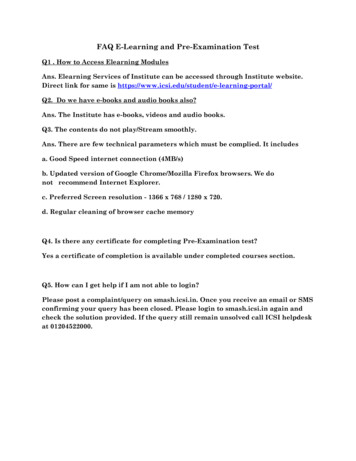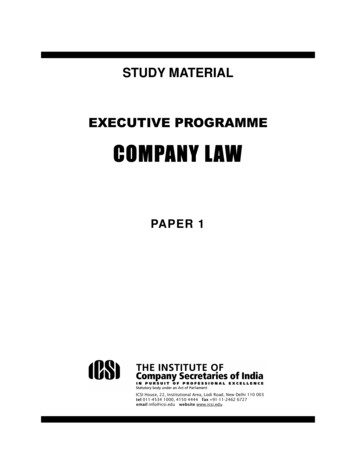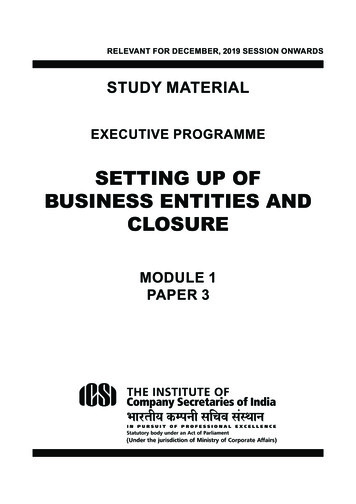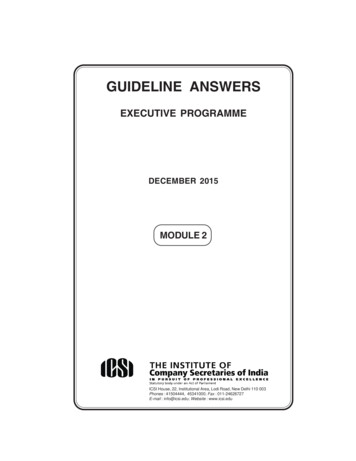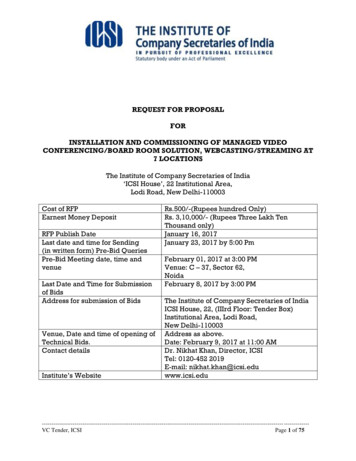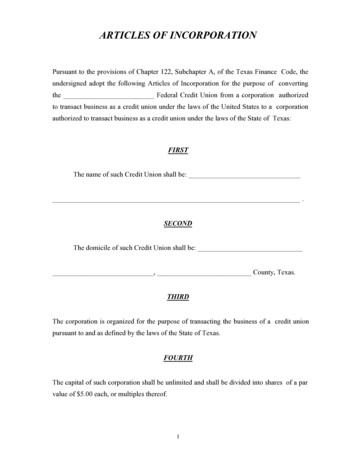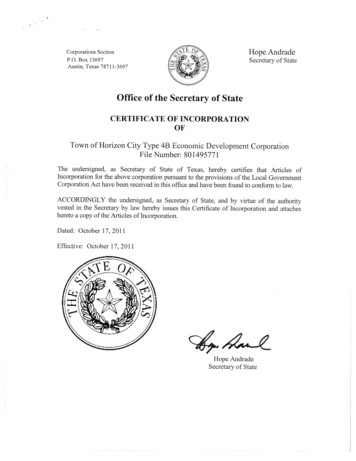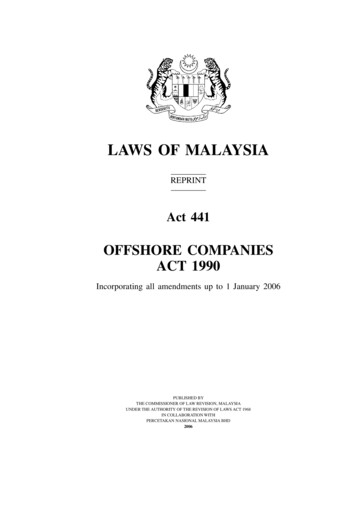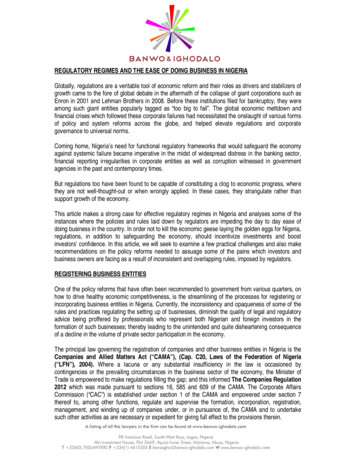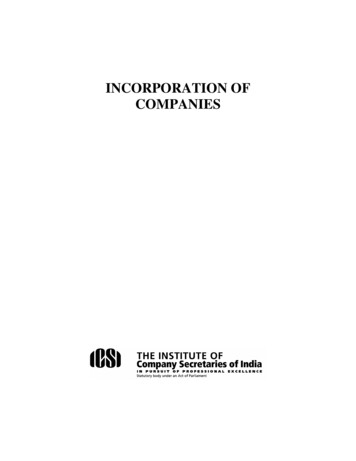
Transcription
INCORPORATION OFCOMPANIES
AGUST 2015PRICE: 150/- (Excluding Postage) THE INSTITUTE OF COMPANY SECRETARIES OF INDIAAll rights reserved. No part of this publication may be translated orcopied in any form or by any means without the prior writtenpermission of The Institute of Company Secretaries of India.Published by:THE INSTITUTE OF COMPANY SECRETARIES OF INDIAICSI House, 22, Institutional Area, Lodi Road, New Delhi - 110003Phones: 4534 1000, Fax: 24626727Website: www.icsi.edu E-mail: info@icsi.eduISBN 978-93-82207-53-5Lasertypesetting at Delhi Computer Services, Dwarka, New Delhi andPrinted at Samrat Offset Works,New Delhi-110092 /100/August 2015(ii)
PREFACECorporate Form of business is a landmark in the evolution of humancivilization. Formal incorporation of companies has many immediatebenefits for the companies and for stakeholders. Legal entities canoutlive their founders.Economies around the world have taken steps making it easier tostart a business—streamlining procedures by setting up a one-stopshop, making procedures simpler or faster by introducing technologyand reducing or eliminating minimum capital requirements etc. Wheregovernments make registration easy, more entrepreneurs startbusinesses in the formal sector, creating more good jobs andgenerating more revenue for the government.The Government of India has taken various initiatives to encouragesetting up businesses and to improve ease of doing business. TheCompanies Act 2013 has simplified the process of incorporation ofstcompanies. The Ministry of Corporate Affairs has notified on 1 May2015, a new system- an integrated e-form INC-29 for incorporatingcompanies.The Institute as part of its capacity building initiatives under theCompanies Act 2013, decided to bring out the publication on“Incorporation of Companies” to guide the professionals on step bystep procedure of incorporation of various kinds of companies public and private companies, One Person Companies, Section 8Companies and Producer Companies.I place on record my sincere thanks CS Vineet K. Chaudhary CentralCouncil Member and Chairman, Corporate Laws and GovernanceCommittee and CS Ahalada Rao V, Central Council Member for theirvaluable inputs in finalizing the book.I am also thankful to CS Aishwarya Mohan Gehrana and CS VijaySharma, Practising Company Secretaries in preparation of basicmanuscript and to CS Henry Richard, Retd. Regional Director, SouthEastern Region, Ministry of Corporate Affairs for his valuable inputs.I commend the dedicated efforts put in by team ICSI led by CS AlkaKapoor, Joint Secretary and comprising CS Banu Dandona, DeputyDirector, CS Nishita Singhal, Assistant Education Officer in finalizingthe publication under the overall guidance of CS Sutanu Sinha, ChiefExecutive & Officiating Secretary , ICSI.I have great pleasure in introducing this book to the professionalfraternity. I am sure this publication will be of immense practical valueto entrepreneurs, professionals and practitioners.I welcome your suggestions for further value additions to thispublication.DatePlace: 07.08.2015: MumbaiCS Atul H. MehtaPresident(iii)
INDEX1.An Introduction to Incorporation of Companies 12.Incorporation of Companies - Legal Provisions 63.Process of Incorporation of Companies 124.Digital Signature Certificates (DSC) 135.Director’s Identification Number (DIN) 186.Incorporation of Companies throughIntegrated Incorporation Form (Inc – 29) 27Stage Wise Forms 45A. Private Company (Other thanOPC)/Public Company 45 49 68 Appointment of Directors 78 Registered Office 81B. One Person Company 86C. Companies With Charitable Objects 95D. Producer Company 106(i) Permanent Account Number ofProposed Director and subscribers 112(ii) Attachments to INC-7/INC-29 116(iii) List of Main Industrial Division(Business Code Activity) andList of Business/Profession Codes 124(iv) Important provisions of Companies Act,2013 and the Rules there undergoverning incorporation of company 128(v) Statewise stamp duty 1487.Incorporation of Companies through Various Reservation of Names in INC-1 Application for Incorporation ofCompany8.Annexures(v)
1. INCORPORATION OF COMPANIES AN INTRODUCTIONBusiness enterprises can be broadly divided into two categories,namely, one which is unincorporated and the other which isincorporated. The basic difference between the incorporated and theun-incorporated form of organisation is that while an un-incorporatedform of business may be started without registration, corporate formof organisations cannot be set up without registration under the lawswhich govern their functioning. Company form of organization is themost popular form of corporate organization.Company is characterised by the fact that ownership andmanagement are separate. The capital of the company is providedby a group of people called shareholders who entrust themanagement of the company in the hands of persons known as theBoard of Directors. A company is an artificial legal person created byprocess of law which makes it an entity separate and distinct from itsmembers who constitute it. As a natural consequence ofincorporation and transferability of shares, the company hasperpetual succession. It can be said that company form oforganisation is suitable when the capital requirements of a businessare large, the liability of members is expected to be limited and therisks need to be spread among a larger number of persons.Formation of company is a process which results in incorporation ofa company. In all jurisdictions, company laws deals with fine detailsrelated to incorporation, objects, legal compliances, mergeramalgamation and winding up of companies. In India, we presentlyhave the Companies Act, 2013 to govern companies in India. We willdiscuss procedural part of formation of the company up toincorporation in this book.DEFINITIONS1. Company: Company means a company incorporated under thisAct or under any previous company law; [Section 2(20)]A company may be a limited by guarantee or by shares or it may bean unlimited company.(i) “Company Limited by Guarantee” means a companyhaving the liability of its members limited by thememorandum to such amount as the members mayrespectively undertake to contribute to the assets of thecompany in the event of its being wound up. [Section 2(21)]The contribution from members are postponed to the eventcalled winding up.
2Incorporation of Companies(ii) “Company Limited by Shares” means a company havingthe liability of its members limited by the memorandum to theamount, if any, unpaid on the shares respectively held bythem; [Section 2(22)]. The contribution from members iscurrent requirement at the time of incorporation or call. Thereis no liability for members holding fully paid up shares.The companies limited by shares may be private company or publiccompany. There is an addition called “One Person Company” inCompanies Act 2013.(i) “One Person Company” means a company which has onlyone person as a member; [Section 2(62)](ii) “Private Company” means a company having a minimumpaid-up share capital as may be prescribed, and which by itsarticles,—(i) restricts the right to transfer its shares;(ii) except in case of One Person Company, limits thenumber of its members to two hundred:Provided that where two or more persons hold one or moreshares in a company jointly, they shall, for the purposes ofthis clause, be treated as a single member:Provided further that—(A) persons who are in the employment of the company;and(B) persons who, having been formerly in theemployment of the company, were members of thecompany while in that employment and havecontinued to be members after the employmentceased, shall not be included in the number ofmembers; and(iii) prohibits any invitation to the public to subscribe for anysecurities of the company; [Section 2(68)](iii) “Public Company” means a company which—(a) is not a private company;(b) has a minimum paid-up share capital, as may beprescribed:Provided that a company which is a subsidiary of a company,not being a private company, shall be deemed to be publiccompany for the purposes of this Act even where suchsubsidiary company continues to be a private company in itsarticles.
Incorporation of Companies32. “Holding Company” in relation to one or more other companies,means a company of which such companies are subsidiarycompanies; [Section 2(46)]3. “Subsidiary Company” or “subsidiary”, in relation to any othercompany (that is to say the holding company), means a company inwhich the holding company—(a) controls the composition of the Board of Directors; or(b) exercises or controls more than one-half of the total sharecapital either at its own or together with one or more of itssubsidiary companies:Provided that such class or classes of holding companies asmay be prescribed shall not have layers of subsidiariesbeyond such numbers as may be prescribed.(This proviso isnot notified)Explanation.—For the purposes of this clause,—(a) company shall be deemed to be a subsidiary company of theholding company even if the control referred to in sub-clause(i) or sub-clause (ii) is of another subsidiary company of theholding company;(b) the composition of a company’s Board of Directors shall bedeemed to be controlled by another company if that othercompany by exercise of some power exercisable by it at itsdiscretion can appoint or remove all or a majority of thedirectors;(c) the expression “company” includes any body–corporate;(d) “layer” in relation to a holding company means its subsidiaryor subsidiaries; [Section 2(87)]4. “Government Company” means any company in which not lessthan fifty one percent of the paid-up share capital is held by theCentral Government, or by any State Government or Governments,or partly by the Central Government and partly by one or more StateGovernments, and includes a company which is a subsidiarycompany of such a Government company. [Section 2(45)]5. Companies with Charitable ObjectsCompany which intends to apply its profits or other income inpromoting its objects whichmay be the promotion ofcommerce, art, science, sports, education, research, socialwelfare, religion, charity, protection of environment or any suchother object and prohibit payment of any dividend is a differentcategory under Section 8 of the Companies Act, 2013.
4Incorporation of Companies6. Producer CompanyProducer Companies is a company which has one or more of thefollowing objects given in Section 58 of Companies Act,1956:(a) Production, harvesting, procurement, grading, pooling,handling, marketing, selling, export of primary produce ofmembers or import of goods or services for their benefits:Provided that the Producer Company may vary on any of theactivities specified in this clause either or through otherinstitution;(b) Processing including preserving, drying, distilling, brewing,venting, canning and packaging of produce of its Members;(c) Manufacture, sale or supply of machinery, equipment orconsumables mainly to its Members;(d) Providing education on the mutual assistance principles to itsMembers and others;(e) Rendering technical services, consultancy services, training,research and development and all other activities for thepromotion of the interests of its Members;(f) Generation, transmission and distribution of power,revitalisation of land and water resources, their use,conservation and communications relatable to primaryproduce;(g) insurance of producers or their primary produce;(h) Promoting techniques of mutuality and mutual assistance;(i) Welfare measures or facilities for the benefit of Members asmay be decided by the Board;(j) Any other activity, ancillary or incidental to any of theactivities referred to in clauses (a) to (i) or other activitieswhich may promote the principles of mutuality and mutualassistance amongst the Members in any other manner;(k) Financing of procurement, processing, marketing or otheractivities specified in clauses (a) to (j) which includeextending of credit facilities or any other financial services toits Members.Note* In terms of first proviso to section 465, the provisionsof Part IX A of The Companies Act,1956 shall be applicablemutatis matndis to a producer company in a manner as if theCompanies Act,1956 has not been repealed until a SpecialAct is enacted for producer companies.
Incorporation of Companies57. “Promoter” means a person—(a) who has been named as such in a prospectus or is identifiedby the company in the annual return referred to in section 92;or(b) who has control over the affairs of the company, directly orindirectly whether as a shareholder, director or otherwise; or(c) in accordance with whose advice, directions or instructionsthe Board of Directors of the company is accustomed to act:Provided that nothing in sub-clause (c) shall apply to aperson who is acting merely in a professional capacity.8. “Member”, in relation to a company, means—(i) the subscriber to the memorandum of the company who shallbe deemed to have agreed to become member of thecompany, and on its registration, shall be entered asmember in its register of members;(ii) every other person who agrees in writing to become amember of the company and whose name is entered in theregister of members of the company;(iii) every person holding shares of the company and whosename is entered as a beneficial owner in the records of adepository;
6Incorporation of Companies2. INCORPORATION OF COMPANIES LEGALPROVISIONSThe Companies Act, 2013 provides for the kinds of companies thatcan be promoted and registered under the Act.Formation of CompanySection 3(1) of the Companies Act 2013 states that a company maybe formed for any lawful purpose by—(a) seven or more persons, where the company to be formed isto be a public company;(b) two or more persons, where the company to be formed is tobe a private company; or(c) one person, where the company to be formed is to be OnePerson Company that is to say, a private company, bysubscribing their names or his name to a memorandum andcomplying with the requirements of this Act in respect ofregistrationA company formed under Section 3(1) may be either—(a) a company limited by shares; or(b) a company limited by guarantee; or(c) an unlimited company.Memorandum of AssociationThe Memorandum of Association is a document which sets out theconstitution of a company and is therefore the foundation on whichthe structure of the company is built. It defines the scope of thecompany’s activities and its relations with the outside world. TheMemorandum of Association is the charter of a company. It is adocument, which amongst other things, defines the area within whichthe company can operate. Section 4(1) states that the memorandumof a company shall state—(a) the name of the company with the last word “Limited” in thecase of a public limited company, or the last words “PrivateLimited” in the case of a private limited company(b) the State in which the registered office of the company is tobe situated;(c) the objects for which the company is proposed to beincorporated and any matter considered necessary infurtherance thereof;(d) the liability of members of the company, whether limited or
Incorporation of Companies7unlimited, and also state,— (i) in the case of a companylimited by shares, that liability of its members is limited to theamount unpaid, if any, on the shares held by them; and (ii) inthe case of a company limited by guarantee, the amount upto which each member undertakes to contribute— (A) to theassets of the company in the event of its being wound-upwhile he is a member or within one year after he ceases tobe a member, for payment of the debts and liabilities of thecompany or of such debts and liabilities as may have beencontracted before he ceases to be a member, as the casemay be; and (B) to the costs, charges and expenses ofwinding-up and for adjustment of the rights of thecontributories among themselves;(e) in the case of a company having a share capital,— (i) theamount of share capital with which the company is to beregistered and the division thereof into shares of a fixedamount and the number of shares which the subscribers tothe memorandum agree to subscribe which shall not be lessthan one share; and (ii) the number of shares eachsubscriber to the memorandum intends to take, indicatedopposite his name;(f) in the case of One Person Company, the name of the personwho, in the event of death of the subscriber, shall becomethe member of the company.Articles of associationIn terms of section 5(1), the articles of a company shall contain theregulations for management of the company. The articles ofassociation of a company are its bye-laws or rules and regulationsthat govern the management of its internal affairs and the conduct ofits business. The articles play a very important role in the affairs of acompany. It deals with the rights of the members of the companyinter se. They are subordinate to and are controlled by thememorandum of association.Section 5(2) provides that the articles shall also contain suchmatters, as may be prescribed. However, nothing prescribed in thissub-section shall be deemed to prevent a company from includingsuch additional matters in its articles as may be considerednecessary for its management. The articles of a company shall be inrespective forms specified in Tables, F, G, H, I and J in Schedule I asmay be applicable to such company. [Section 5(6)].A company may adopt all or any of the regulations contained in themodel articles applicable to such company. [Section 5(7)]Section 5(8) provides that in case of any company, which is
8Incorporation of Companiesregistered after the commencement of Companies Act 2013, in so faras the registered articles of such company do not exclude or modifythe regulations contained in the model articles applicable to suchcompany, those regulations shall, so far as applicable, be theregulations of that company in the same manner and to the extent asif they were contained in the duly registered articles of the company.Entrenchment ProvisionsThe Companies Act, 2013 recognizes an interesting concept ofentrenchment. Essentially, the entrenchment provisions allow forcertain clauses in the articles to be amended upon satisfaction ofcertain conditions or restrictions (such as obtaining a 100% consent)greater than those prescribed under the Act. This shall empower theenforcement of any pre-agreed rights and provide greater certainty toinvestors, especially in joint ventures. The provisions forentrenchment referred to in section 5(3) shall be made either onformation of a company, or by an amendment in the articles agreedto by all the members of the company in the case of a privatecompany and by a special resolution in the case of a publiccompany. [Section 5 (4)]Where the articles contain provisions for entrenchment, whethermade on formation or by amendment, the company shall give noticeto the Registrar of such provisions in such form and manner as maybe prescribed. [Section 5 (5)]Incorporation of a CompanySection 7(1) provides that at the time of incorporation of a companythere shall be filed with the Registrar within whose jurisdiction theregistered office of a company is proposed to be situated, thefollowing documents and information for registration, namely:—(a) the memorandum and articles of the company duly signed byall the subscribers to the memorandum in such manner asmay be prescribed;(b) a declaration in the prescribed form by an advocate, achartered accountant, cost accountant or company secretaryin practice, who is engaged in the formation of the company,and by a person named in the articles as a director, manageror secretary of the company, that all the requirements of thisAct and the rules made thereunder in respect of registrationand matters precedent or incidental thereto have beencomplied with;(c) an affidavit from each of the subscribers to the memorandumand from persons named as the first directors, if any, in thearticles that he is not convicted of any offence in connectionwith the promotion, formation or management of any
Incorporation of Companies9company, or that he has not been found guilty of any fraud ormisfeasance or of any breach of duty to any company underthis Act or any previous company law during the precedingfive years and that all the documents filed with the Registrarfor registration of the company contain information that iscorrect and complete and true to the best of his knowledgeand belief;(d) the address for correspondence till its registered office isestablished;(e) the particulars of name, including surname or family name,residential address, nationality and such other particulars ofevery subscriber to the memorandum along with proof ofidentity, as may be prescribed, and in the case of asubscriber being a body corporate, such particulars as maybe prescribed;(f) the particulars of the persons mentioned in the articles as thefirst directors of he company, their names, includingsurnames or family names, the Director IdentificationNumber, residential address, nationality and such otherparticulars including proof of identity as may be prescribed;and(g) the particulars of the interests of the persons mentioned inthe articles as the first directors of the company in other firmsor bodies corporate along with their consent to act asdirectors of the company in such form and manner as maybe prescribed.(2) The Registrar on the basis of documents and information filedunder sub-section (1) shall register all the documents andinformation referred to in that subsection in the register and issue acertificate of incorporation in the prescribed form to the effect that theproposed company is incorporated under this Act.(3) On and from the date mentioned in the certificate of incorporationissued under sub-section (2), the Registrar shall allot to the companya corporate identity number, which shall be a distinct identity for thecompany and which shall also be included in the certificate.(4) The company shall maintain and preserve at its registered officecopies of all documents and information as originally filed under subsection (1) till its dissolution under this Act.(5) If any person furnishes any false or incorrect particulars of anyinformation or suppresses any material information, of which he isaware in any of the documents filed wit the Registrar in relation to theregistration of a company, he shall be liable for action under section447.
10Incorporation of Companies(6) Without prejudice to the provisions of sub-section (5) where, atany time after the incorporation of a company, it is proved that thecompany has been got incorporated by furnishing any false orincorrect information or representation or by suppressing anymaterial fact or information in any of the documents or declarationfiled or made for incorporating such company, or by any fraudulentaction, the promoters, the persons named as the first directors of thecompany and the persons making declaration under clause (b) ofsubsection (1) Shall each be liable for action under section 447.The Companies (Incorporation) Rules 2014 deals with incorporationof companies in India.Presently, there are two routes to incorporate companies in India:A. Incorporation of companies through IntegratedIncorporation E-Form i.e. e-Form INC – 29: To simplifyand fast track the procedure for company registration inIndia, the Ministry of Corporate Affairs (MCA) has introducedE-Form INC-29 – Integrated Incorporation Form. E-FormINC-29 deals with the single application for reservation ofname, incorporation of a new company and/or application forallotment of DIN-thereby significantly reducing the time takento start a company in India. This e-Form is accompanied bysupporting documents including details of Directors &Subscribers, MoA and AoA etc. Once the e-Form isprocessed and found complete, company would beregistered. Also DINs gets issued to the proposed Directorswho do not have a valid DIN. Maximum three Directors areallowed for using this integrated form for allotment of DINwhile incorporating a company.B. Incorporation of companies through various stage wiseformsPortals for filing of e-forms for incorporation:The e-forms for incorporation of companies under the CompaniesAct 2013 can be uploaded in following two portalsA. MCA 21 portal under Ministry of Corporate Affairs: MCA21 is an ambitious e-Governance project of Ministry ofCorporate Affairs, Government of India. The core objective ofthis project was to transform the Ministry’s mode of workingfrom traditional paper to paperless format. This initiative waslaunched to deliver over 100 services to citizenselectronically covering almost completely the Companies Actof 1956 and now Companies Act 2013. These services areprovided in easy and secured manner via Ministry ofCorporate Affairs portal. The MCA 21 was also the first portal
Incorporation of Companies11under the Government to use the Digital Identity of the users.In recent times the MCA Portal has been revamped and therevamped portal is more user friendly.B. E-BIZ portal under DIPP, Ministry of Commerce and IndustryeBiz is one of the integrated services projects and part of the27 Mission Mode Projects (MMPs) under the National EGovernance Plan (NEGP) of the Government of India. eBizis being implemented by Infosys Technologies Limited(Infosys) under the guidance and aegis of Department ofIndustrial Policy and Promotion (DIPP), Ministry ofCommerce & Industry, Government of India. The focus ofeBiz is to improve the business environment in the countryby enabling fast and efficient access to Government-toBusiness (G2B) services through an online portal. This willhelp in reducing unnecessary delays in various regulatoryprocesses required to start and run businesses.
12Incorporation of Companies3. PROCESS OF INCORPORATION OF COMPANIESThe stepwise process for incorporation of companies is as under-In coming chapters, we will firstly discuss the documents requiredbefore incorporation and then incorporation through integratedincorporation e-form and thereafter will discuss incorporation ofcompanies through various stage wise e-forms.
Incorporation of Companies134. DIGITAL SIGNATURE CERTIFICATES (DSC)Section 18 of the Information Technology Act, 2000, provides therequired legal sanctity to the digital signatures based on asymmetriccrypto systems. The digital signatures are now accepted at par withhandwritten signatures and the electronic documents that have beendigitally signed are treated at par with paper documents. As Physicaldocuments are signed manually, similarly, electronic documents, forexample e-forms are required to be signed digitally using a DigitalSignature Certificate.Types of Digital Signature Certificates (DSC):The different types of Digital Signature Certificates are:Class 2: Here, the identity of a person is verified against a trusted,pre-verified database.Class 3: This is the highest level where the person needs to presenthimself or herself before the Registration Authority (RA) and provehis/ her identity.Note: DSC of Class 2 and Class 3 signing certificate categoriesissued by a licensed Certifying Authority needs to be obtained for eFiling on the MCA Portal.Procedure for obtaining CLASS 2 Digital Signature Certificates(DSC)The Office of Controller of Certifying Authorities, issues Certificateonly to Certifying Authorities (CA). CAs issue Digital SignatureCertificate to end-user. The CAs are authorized to issue a DSC witha validity upto two years. A CA issues DSC in 2 to 7 days. You mayapproach any one CA for getting Digital Signature Certificate. Thewebsite addresses of different CAs are given below: www.safescrypt.com www.nic.in www.idrbtca.org.in www.tcs-ca.tcs.co.in www.ncodesolutions.com www.e-Mudhra.comMTNL and Central Excise and Customs have now closed functioningas CAs.The standard form issued by certifying authority has to be filled and
14Incorporation of Companiesthe following documents are required:1. A a self attested colour photographForm)(affixed on the DSC2. ID Proof (PAN Card Copy is Mandatory)3. Address Proof like Telephone Bill, Electricity Bill or Water Bill. (not olderthan 2 months) Gas connection. (not older than 2 months) Bank Statement Signed by Banker (not older than 2months) Driving Licence Voter ID Card PassportNote: Documents mentioned in points 2 & 3 shall be attested only byBanker, Gazetted officer or Post Master, no professional certificationshall be entertainedRegistration of DSC on MCA 21 PORTALStep by step process to be followed for registration of Director’s DSCis as under:1. Click on the MCA Services and then following page will appear.Click on ‘Register DSC' link available on the MCA portal homepage.2. On the next screen, click on the' Director' link on the left hand panel
Incorporation of Companies153. Fill-up the required details of DIN. Please ensure that the DIN isapproved and typed correctly.
16Incorporation of Companies4. Click on the 'Next' button. The system would verify the details.5. If the details filled do not match with DIR-3/ DIR-6, as the casemay be, for the reason that you do not have your DIN applicationdetails, you can get the details from the company in which you are adirector.6. If the details are correct, the system would prompt you to selectthe DSC. Click on the 'Select Certificate' button to browse and selectthe certificate. Please ensure that the selected DSC belongs to theapplicant, whose particulars are being registered.Note: System shall validate the DSC. If the selected DSC is alreadyregistered against given DIN, system will give an informatorymessage. If a different DSC is already registered against the givenDIN, system will ask if the user wants to update his/ her DSC.7. Type the displayed system generated text for verification in thebox provided.8. Click on 'I agree' button to agree to the declaration that detailsfurnished are correct.
Incorp
2. "Holding Company" in relation to one or more other companies, means a company of which such companies are subsidiary companies; [Section 2(46)] 3. "Subsidiary Company" or "subsidiary", in relation to any other company (that is to say the holding company), means a company in which the holding company—
